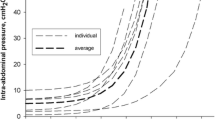Abstract
Background: This study investigated three factors postulated to be sources of physiological stress in laparoscopic surgery: hypercarbia, elevated intraabdominal pressure, and the steep Trendelenburg position. Our research was designed to define the effects of each of these potential stressors on hemodynamic responses observed during laparoscopic colectomy in pigs.
Methods: Twenty-four pigs were randomized into the following four groups, based on the method for obtaining surgical exposure while a colectomy or laparoscopic-assisted colectomy was performed: Open surgery (n = 6), CO2 pneumoperitoneum (n = 6), Helium pneumoperitoneum (n = 6), and abdominal wall Lifter (n = 6). The animals were paralyzed with minute ventilation adjusted. All animals underwent extensive pulmonary and hemodynamic monitoring with measurements of the following parameters: RR, Vt, minute ventilation, O2, sat, ETCO2, PVR, HR, MAP, CO, PAP, CVP, PCWP, SV, LVSWI, DO2, and VO2. The laparoscopic pigs were placed in the steep Trendelenburg position during surgery.
Results: The effect of a CO pneumoperitoneum was to increase PaCO2 PVR and cause an acidemia that could not be prevented by an increase in minute ventilation. Elevated intraabdominal pressure decreased UO. Both pneumoperitoneum groups had a fourfold increase in IVCP, a measure of intraabdominal pressure. Some of this increase was due to placement into the Trendelenburg position; IVCP increased to a lesser degree in the Lifter group. The steep Trendelenburg position caused significant increases in PAP, CVP, and PCWP; however, a contributory effect of elevated intraabdominal pressure cannot be ruled out. None of these procedures had any significant effect on the HR or MAP. There was a significant increase in CO in the CO2 and Lifter groups; however, when CO was controlled for HR effects, there was no significant effect on SV from any of these different procedures. LVSWI, DO2, and VO2 were not affected by any of the different exposure methods.
Conclusions: The effects of laparoscopic surgery and open surgery on hemodynamic responses are minimal, and no one method is superior to another when performed in pigs that are healthy, hydrated, and hyperventilated to keep ETCO2 <40. However, since elderly and sick patients have a lower threshold for physiologic decompensation, we can infer that the small hemodynamic changes noted in this study might become significant factors when surgery is performed on compromised patients. The finding that an abdominal wall lifting device causes the fewest metabolic and hemodynamic effects makes its use an important consideration when performing laparoscopic surgery in patients with cardiopulmonary compromise, hemodynamic instability, or any preexisting renal insufficiency.
Similar content being viewed by others
Author information
Authors and Affiliations
Rights and permissions
About this article
Cite this article
Horvath, K., Whelan, R., Lier, B. et al. The effects of elevated intraabdominal pressure, hypercarbia, and positioning on the hemodynamic responses to laparoscopic colectomy in pigs. Surg Endosc 12, 107–114 (1998). https://doi.org/10.1007/s004649900608
Issue Date:
DOI: https://doi.org/10.1007/s004649900608




